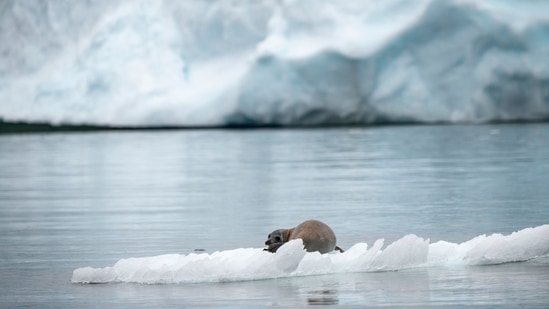Arctic sea ice loss triggering extreme Sept rains in India: Study
Summer sea ice loss in the Kara Sea region of the Arctic may be triggering extreme monsoon rainfall events in central India in the month of September, a new paper has suggested
Summer sea ice loss in the Kara Sea region of the Arctic may be triggering extreme monsoon rainfall events in central India in the month of September, a new paper has suggested.

The research, led by the National Centre for Polar and Ocean Research under the ministry of earth sciences, has found that the frequency of extreme rainfall events (daily rainfall >150 mm) in central India in September displayed a consistently increasing trend with declining summer sea ice extent during the Early Twentieth Century Warming (ETCW, 1920–1940) period and recent warming since the 1980s.
The trend was found to be stronger in the recent warming period after the 1980s, the paper, ‘A possible relation between Arctic sea ice and late season Indian Summer Monsoon Rainfall extremes’, said.
Since the beginning of the satellite records in 1979, the Arctic Sea Ice Extent (SIE) has been declining at a rate of about 4.4% per decade in annual mean, the paper published in the journal Nature on June 22 said.
While it is still unclear if this rapid sea ice decline can influence extreme weather events in the tropics, or the extreme rainfall events during monsoon in India, scientists from NCPOR have proposed that it may be causing a high-pressure area over Northwest Europe. The scientists have found that extreme rainfall events in late monsoon can be induced by the sea ice decline.
The authors said that the upper level atmospheric circulation changes due to Arctic sea ice loss and very warm sea surface temperatures over the Arabian Sea could together contribute to increase in extreme monsoon rain in central India, particularly in the month of September.
“As the sea ice reduces in the Barents-Kara Sea region of the Arctic Ocean, it allows more convection and upward air motion over the open ocean during summer. This air then descends at a further south location over northwest Europe and intensifies a deep anticyclonic atmospheric circulation. The associated meandering of the jet stream also contributes to it. This abnormal upper atmospheric disturbance is then further propagated towards subtropical Asia extending over the Indian landmass. The upper-level atmospheric circulation change along with an above-normal Arabian Sea surface temperature help in enhanced convection and moisture supply - resulting in extreme rainfall events during August-September,” said Sourav Chatterjee, lead author from NCPOR.
In 2015, a paper by meteorologist TN Krishnamurti of Florida State University, proposed that the heat released in the atmosphere during extreme rainfall events over northwest India ultimately travels to the Canadian Arctic region causing significant sea ice loss in the Arctic.
The effects of Arctic Sea ice changes on the mid-latitudes are still debated but it is often proposed that increase in mid-latitude extreme weather events is associated with Arctic Amplification induced loss in sea ice. Over the past 30 years, the Arctic has warmed at twice the rate as the entire globe — this phenomenon is known as Arctic Amplification, according to the US’s National Snow and Ice Data Center.
“We started by looking at over 100 years of observational records of summer monsoon rainfall and sea ice in the Arctic. During the two episodes of rapid sea ice decline in the Arctic Ocean (1920-1940 and 1980-present) the frequency of extreme rainfall events consistently increase. This motivated us to look at the relationship between extreme rainfall and sea ice in the Arctic. Earlier studies had shown the potential mid-latitude influences on the monsoon. We further investigated the possible impact of sea ice loss in this mid-latitude influence on the monsoon extremes,” Chatterjee said, underlining that impacts of such atmospheric circulation changes are most prominent over the west and central India, and parts of the west coast.
“In summary, our results indicate since the 1980s, rapidly declining summer sea ice extent in the Kara Sea region exhibits a more robust relationship with the frequency of Indian Summer Monsoon Rainfall extremes, compared to mean ISMR intensity; extreme precipitation events in central India during the late phase of ISMR season can be explained by the combined effect of the upper atmospheric circulation anomalies resulting from reduced sea ice extent and low-level circulation anomalies over west-central India supported by warm sea surface temperature anomalies in the north-western Arabian Sea,” the paper said.
“Changes in sea-ice extent in the Arctic influences large-scale atmospheric patterns, and it is possible that there is an impact on the monsoon too. While the causative mechanisms are not that clear, there is one factor that is definitive—the extreme rainfall events during the monsoon have increased three-fold in the recent decades. Since these extreme rains happen over a short spell of a few hours to few days over a large area, chances of floods are high—which means that we need to work on flood warning systems across the country,” said Roxy Mathew Koll, climate scientist, India Indian Institute of Tropical Meteorology (IITM). Roxy’s paper published in Nature journal in 2017 concluded that there was a threefold rise in extreme rain along the west coast and central India during 1950 to 2015.






